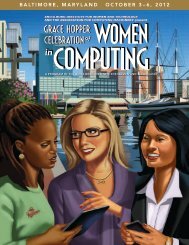ABI-ONE ghc program v14.indd - Grace Hopper Celebration of ...
ABI-ONE ghc program v14.indd - Grace Hopper Celebration of ...
ABI-ONE ghc program v14.indd - Grace Hopper Celebration of ...
You also want an ePaper? Increase the reach of your titles
YUMPU automatically turns print PDFs into web optimized ePapers that Google loves.
GENERAL POSTER SESSION<br />
W e d n e s d ay | s e p T 3 0<br />
Girls, Games, and Getting to the First<br />
Day<br />
Presenter: Gillian Smith (University <strong>of</strong><br />
California at Santa Cruz)<br />
Middle and high school education is<br />
crucial in shaping girls’ perceptions<br />
<strong>of</strong> computing. Game design challenges<br />
misconceptions about computing and<br />
introduces computational thinking, but may<br />
be unappealing to some girls. This poster<br />
overviews the effectiveness <strong>of</strong> game design<br />
for increasing girls’ interest in computing,<br />
compares several languages for teaching<br />
young students, and shares experiences<br />
with mixed versus single-gender groups.<br />
Giving Students Automatic Feedback<br />
on Java Program Design<br />
Presenter: Hannah Blau (University <strong>of</strong><br />
Massachusetts, Amherst)<br />
This research will partially automate the<br />
process <strong>of</strong> giving students feedback<br />
on the design <strong>of</strong> their Java <strong>program</strong>s. My<br />
goal is to diagnose silent design flaws that<br />
produce no compile-time or runtime errors,<br />
no incorrect output. These flaws include<br />
inappropriate subclassing, a constructor that<br />
runs the entire <strong>program</strong>, instance variables<br />
that should have been local variables. These<br />
mistakes are characteristic <strong>of</strong> <strong>program</strong>mers<br />
who have not yet assimilated the objectoriented<br />
idiom.<br />
Global Social Entrepreneurship<br />
Presenter: <strong>Grace</strong> (Ge) Wang (University <strong>of</strong><br />
California, San Diego)<br />
We will discuss some <strong>of</strong> our experiences<br />
in the past year as we<br />
transitioned TIES, an experiential learning<br />
<strong>program</strong> at UCSD, to a <strong>program</strong> that focuses<br />
on establishing collaborations on a global<br />
scale. We will discuss some <strong>of</strong> our current<br />
projects and collaborations, highlight some<br />
<strong>of</strong> our accomplishments in the past year, and<br />
some <strong>of</strong> the challenges that we encountered<br />
in the course <strong>of</strong> our transition.<br />
Graph Based Mining On Weighted<br />
Directed Graphs<br />
Presenter: Sijin Abdulkarim (Indiana<br />
University - Purdue University<br />
Indianapolis)<br />
Weighted and directed graphs are highly<br />
significant in biological networks.<br />
A novel sub-network mining algorithm<br />
was developed to find the most significant<br />
pathways from a weighted directed network.<br />
A biological problem associated with Limb<br />
regeneration was used to evaluate the<br />
performance <strong>of</strong> the algorithm. The subnetworks<br />
those are obtained were further<br />
validated using the canonical pathways<br />
found from the literature.<br />
Grid Infrastructure Based Forensic<br />
Analysis for Combating Global<br />
Terrorism<br />
Presenter: Jyotsana Sharma (Thapar<br />
University)<br />
Today, every nation relies on interconnected<br />
computer systems. The access<br />
to information networks via the Internet<br />
enables even small terrorist outfits to wreak<br />
disaster. Forensic analysis <strong>of</strong> network<br />
traffic can prove useful in detecting and<br />
preventing such terrorist attacks, but the<br />
archiving and analysis is highly resource<br />
intensive. Successful implementation <strong>of</strong><br />
grid computing to various computationally<br />
intensive scientific and academic problems<br />
has encouraged us to attempt the application<br />
<strong>of</strong> grid computing to the terrorism<br />
problem.<br />
GUANYIN: A Cloud Computing<br />
Infrastructure for Perpetual Checking <strong>of</strong><br />
Deployed S<strong>of</strong>tware<br />
Presenter: Yunling Wang (Columbia<br />
University)<br />
Thorough checking <strong>of</strong> a s<strong>of</strong>tware product<br />
is now hampered by the ability to detect<br />
all defects (bugs) during the pre-deployment<br />
phases. We propose to build GUANYIN,<br />
the first large-scale distributed s<strong>of</strong>tware<br />
reliability infrastructure. GUANYIN can<br />
drive s<strong>of</strong>tware into a variety <strong>of</strong> states by<br />
performing live checking to capture real<br />
s<strong>of</strong>tware states triggered by large number<br />
<strong>of</strong> end-users. It also leverages idle resources<br />
to provide huge computing power for the<br />
checking.<br />
Hero In Vein<br />
Presenter: Karen Gragg (Harvey Mudd<br />
College)<br />
Hero In Vein is an overhead shooter<br />
meant to educate and raise awareness<br />
about how HIV/AIDS is spread within the<br />
body. In this game, the player is a B cell<br />
who must help protect its host body from an<br />
assault by HIV/AIDS. The ultimate goal is to<br />
repress HIV/AIDS into its latency stage, so<br />
that the afflicted individual can live a long<br />
and happy life.<br />
High Performance LINPACK on<br />
Graphics Processing Units<br />
Presenter: Priyanka Agrawal (National<br />
Institute <strong>of</strong> Technology Surat)<br />
High-Performance LINPACK Benchmark<br />
is used as a performance measure<br />
for ranking supercomputers in the TOP500<br />
list. We study Graphics Processing Units<br />
as an approach for efficient execution <strong>of</strong><br />
HPL. The results <strong>of</strong> our study indicate that<br />
HPL involves large amount <strong>of</strong> data transfer<br />
between CPU and GPU and thus GPU parallelism<br />
cannot be fully exploited. Here, we<br />
propose some optimizations to reduce data<br />
transfers and achieve maximum speedup <strong>of</strong><br />
HPL.<br />
How “Birds <strong>of</strong> a Feather Flock<br />
Together” on Online Social Spaces<br />
Presenter: Munmun De Choudhury<br />
(Arizona State University)<br />
Over several decades, social scientists<br />
have been interested in the idea<br />
that “similarity breeds connection” i.e.<br />
“homophily”. Homophily structures the<br />
ego-networks <strong>of</strong> individuals and is therefore<br />
54 Anita Borg Institute for Women and Technology | <strong>Grace</strong> <strong>Hopper</strong> <strong>Celebration</strong> <strong>of</strong> Women in Computing




